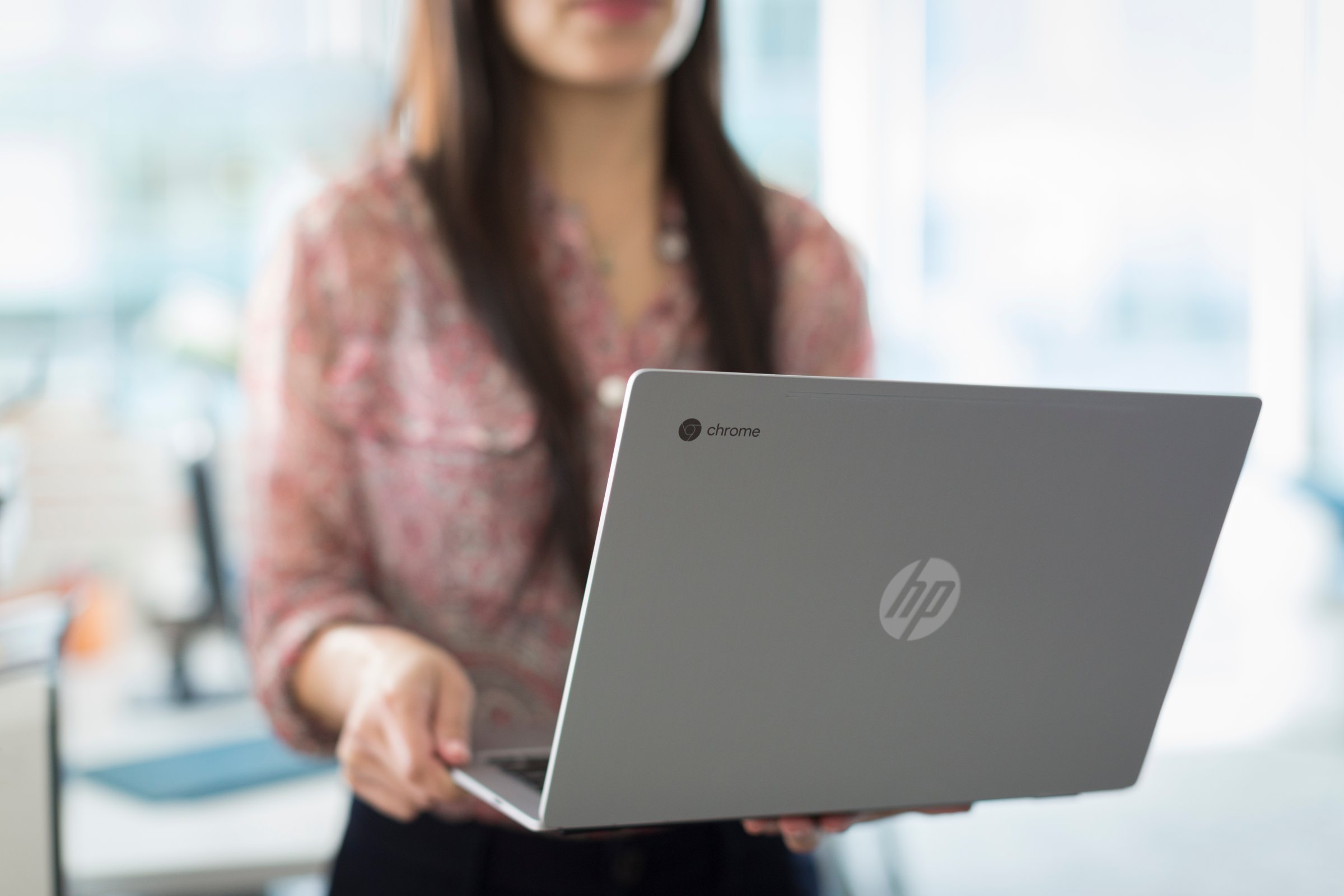
The good: Thin and attractive design, Comfortable keyboard, Decent battery life
The bad: Sticky mouse button, Expensive compared to most other Chromebooks
Who should buy: Those who primarily use their laptop for browsing the Web and are seeking something premium yet easy-to-use.
Thanks to the rise of Chromebooks, it’s easier than ever to find a basic yet functional laptop for less than $400. But while Chromebooks have improved significantly over the last five years, buying one still means making tradeoffs. Chromebooks are (typically) inexpensive, but their Chrome OS operating system can’t handle demanding software like Photoshop or complex video games. And aside from Google’s pricey $1,299 Pixel, some models feel cheap compared to Windows and Mac laptops.
Recently, however, Google and its partners have strived to make Chromebooks feel more like full-fledged PCs. A standout example is HP’s new Chromebook 13, among the few such computers to feature a polished, refined design that feels more like an Apple product. Google also recently announced that Android apps are coming to the Chrome ecosystem, giving some Chromebook owners plenty of new software to use.
The new hardware and the incoming bounty of apps make the case for buying a Chromebook stronger than ever. But these inexpensive machines still aren’t for everybody. Here’s a closer look at what it’s been like to use the HP Chromebook 13 for the past several days.
Hardware
When closed, the Chromebook 13 looks like a flat, sleek sheet of aluminum. As you lift the lid and power it on, the backlit keyboard begins to gleam. These are superficial details, but they’re a refreshing change from the plethora of plasticky Chromebooks out there. Still, this quality comes at a cost: depending on which configuration you choose, the Chromebook 13 can cost anywhere between $500 and $800. That’s on par with some mid-range Windows devices.
The $500 entry level version is powered by an Intel Pentium processor, comes with 32GB of storage, 4GB of memory, and has a 13.3-inch 3,200×1,800 resolution screen. Paying $600 gets you a Core m3 processor, but leaves the same storage, memory, and display. For $819, you get a more powerful Core m5 processor, 8GB of RAM, and the same display and amount of storage. Further customization options allow you to swap out the processor and upgrade to a Core m7, choose a lower resolution 1920×1080 screen, or add more memory.
Who’s it for?
HP’s Chromebook 13 is suitable for most work-related tasks and casual needs. I used it as my primary work computer for two days, and found it was sufficient for handling most of my daily responsibilities, like writing, editing, researching, and communicating with coworkers.
Chromebooks tend to rely heavily on the Internet, but I barely noticed when my Chromebook 13 lost its connection — Google Drive and Gmail, among other apps, have workable offline modes. In a nod to office workers, the Chromebook 13 supports virtual desktop software for accessing workplace programs remotely. But connecting the Chromebook 13 to a larger external monitor means buying an adapter or a dock — HP sells one for $149.
Testing it out
The Chromebook 13 is (mostly) a pleasure to use. The spacious keyboard, with its deep key travel, provides rich and tactile feedback that makes it easy to type quickly. It doesn’t feel flimsy or mushy when you press down on the keys, as is the case with some cheaper notebooks. The screen is crisp and clear enough to make for an enjoyable viewing experience when watching Netflix or viewing photos.
My two complaints: The Chromebook 13’s screen can catch distracting glare, making it harder to view. Meanwhile, the touchpad’s mouse button felt clunky and sticky, requiring a harder press than usual to register a click. That sounds minor, but it grew irritating after a few days of use.
The Chromebook 13’s battery lasted long enough to get me through nearly an entire workday. I was able to use the computer for roughly seven and a half hours before it died, which is on par with competitors like the Toshiba Chromebook 2 and the Lenovo ThinkPad 11e Chromebook, as PCMag and The Wirecutter have noted in their tests. That should get the job done for most users, but those who want to really go off the grid should shop around. Dell’s Chromebook 13 is said to get nearly 17 hours of battery life, while Acer’s Chromebook 14 reportedly lasts for more than 11 hours.
Final word
The HP Chromebook 13 is high-performing yet simple laptop that makes very few compromises. Those who already know they want a Chromebook and aren’t necessarily looking for the cheapest option certainly won’t be disappointed. At about half the price of Google’s Pixel, it’s the first affordable, truly premium Chromebook.
That said, it’s worth taking a long look at your other options before pulling the trigger. Cheaper Chromebooks, while they may not be as attractive or comfortable to type on as HP’s latest, still offer a solid experience for hundreds of dollars less. The $300 Toshiba Chromebook 2 and $249 Asus Chromebook Flip, while they have have less memory and storage, are two strong examples. A Chromebook can be great option for those who want a very basic computer that requires no maintenance, making them an ideal choice for classrooms, kids, and grandparents. But if you’re going to commit $500 to $800 for a new computer, it’s worth thinking about whether you want that to be a Chromebook or a more traditional PC.
3.5 out of 5 stars
More Must-Reads from TIME
- Why Trump’s Message Worked on Latino Men
- What Trump’s Win Could Mean for Housing
- The 100 Must-Read Books of 2024
- Sleep Doctors Share the 1 Tip That’s Changed Their Lives
- Column: Let’s Bring Back Romance
- What It’s Like to Have Long COVID As a Kid
- FX’s Say Nothing Is the Must-Watch Political Thriller of 2024
- Merle Bombardieri Is Helping People Make the Baby Decision
Contact us at letters@time.com